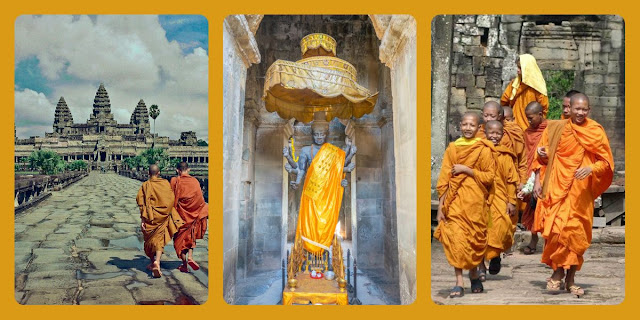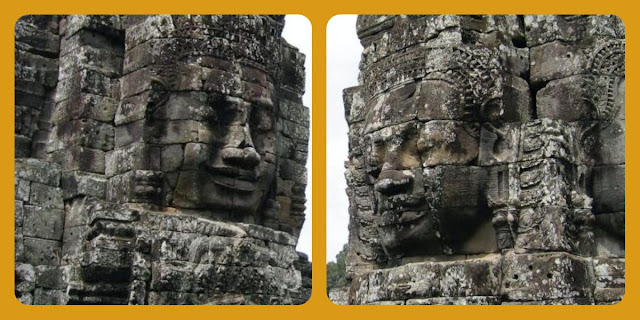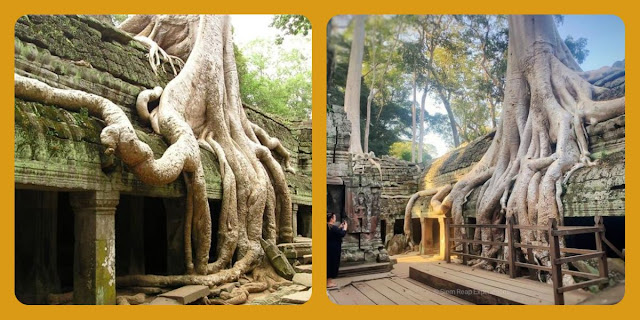Unveiling the Mysteries of Angkor Wat
Nestled amidst the lush jungles of Cambodia lies one of the world's most astonishing architectural and archaeological wonders, Angkor Wat. This ancient temple city, located in the heart of the Angkor Archaeological Park, has captivated the imaginations of travelers and history enthusiasts for centuries. In this article, we will embark on a virtual journey to explore the captivating history, awe-inspiring architecture, and the magical allure of Angkor Wat.
A Glimpse into History
Angkor Wat, built during the reign of King Suryavarman II in the early 12th century, is a testament to the grandeur of the Khmer Empire. Its original purpose remains a subject of debate among historians, but it is widely believed to have served as both a temple and a mausoleum dedicated to the Hindu god Vishnu.
The temple complex was later transformed into a Buddhist site, reflecting the cultural shifts of the Khmer Empire. Its intricate architecture and bas-reliefs tell the stories of Hindu epics and Buddhist legends, offering a glimpse into the religious and cultural tapestry of the time.
Architectural Marvel
Angkor Wat's architecture is nothing short of astounding. Key features include:
- A vast moat and a grand causeway that lead to the central temple.
- A central tower, rising to a height of over 65 meters (213 feet), symbolizing Mount Meru, the cosmic center of Hindu mythology.
- Intricate carvings that adorn the temple walls, depicting scenes from Hindu and Buddhist mythology.
- Galleries with bas-reliefs showcasing historical and mythological narratives.
The temple's alignment with the cardinal points and celestial bodies highlights the Khmer Empire's sophisticated astronomical knowledge and devotion to cosmic symbolism.
Spiritual Significance
Angkor Wat is not just a historical relic; it remains a living spiritual site for Cambodians. Many pilgrims and monks visit the temple to pay their respects and offer prayers. The serene atmosphere within the temple complex encourages reflection and contemplation.
Visiting Angkor Wat
Angkor Wat is an unforgettable experience.
Temple Exploration: Visitors can explore the central temple, its courtyards, galleries, and the upper terraces. Climbing to the summit provides panoramic views of the surrounding jungle.
Sunrise and Sunset Views: Angkor Wat is famous for its stunning sunrise and sunset views. Watching the temple emerge from the dawn mist or witnessing the sun's golden rays illuminate the ancient stone is a magical experience.
Angkor Archaeological Park: Angkor Wat is just one of many temples within the Angkor Archaeological Park. A visit often includes exploration of other nearby temples, such as Angkor Thom, Ta Prohm, and Bayon.
Is Angkor Wat Hindu or Islam?
It was originally built in the 12th century by King Suryavarman II as a dedication to the Hindu god Vishnu. The temple's architecture and artwork are rich in Hindu symbolism and mythology.
However, over the centuries, Cambodia went through periods of religious transformation, and Buddhism became the dominant religion in the region. As a result, Angkor Wat also served as a Buddhist temple at different points in its history.
In summary, Angkor Wat has both Hindu and Buddhist associations in its history, but it was originally constructed as a Hindu temple.
Is Angkor Wat a Tamil temple?
Angkor Wat is not a Tamil temple; it is a Khmer temple. It was built in the 12th century in the Khmer Empire, which was a powerful empire in Southeast Asia, covering parts of what is now Cambodia, Thailand, Laos, and Vietnam. The temple was constructed during the reign of King Suryavarman II and was dedicated to the Hindu god Vishnu.
While there may have been influences from various cultures in the region, including India, in the architecture and religious symbolism of Angkor Wat, it is fundamentally a Khmer architectural and cultural marvel. Tamil temples, on the other hand, are typically associated with the Tamil-speaking people of South India and have their own distinct architectural styles and religious practices.
Why was Angkor Wat built?
Angkor Wat was built as a Hindu temple complex in the 12th century by King Suryavarman II of the Khmer Empire, which was centered in what is now Cambodia. The primary purpose behind the construction of Angkor Wat was to serve as a temple dedicated to the Hindu god Vishnu. It was designed to be a place of worship, religious devotion, and a symbol of the king's devotion to Vishnu.
The temple's architecture and artwork are rich in Hindu symbolism and mythology. The central tower of Angkor Wat, in particular, represents the sacred Mount Meru, which is considered the center of the Hindu universe. The temple complex was also intended to serve as a mausoleum for King Suryavarman II, where his ashes would be interred after his death.
It's worth noting that while Angkor Wat was originally constructed as a Hindu temple, it later transitioned to become a Buddhist temple during periods of religious transformation in Cambodia. Today, it is a UNESCO World Heritage site and a significant archaeological and cultural landmark, visited by people from around the world for its historical and architectural significance.
Why is Angkor Wat so famous?
Angkor Wat is famous for several reasons:
1. Architectural Marvel: Angkor Wat is renowned for its stunning and intricate architecture. It is one of the largest religious monuments in the world and is characterized by its intricate bas-reliefs, intricately carved sandstone galleries, and five soaring towers that symbolize the mythical Mount Meru.
2. Historical Significance: It was built in the 12th century by King Suryavarman II of the Khmer Empire and served as a Hindu temple dedicated to the god Vishnu. It is a remarkable representation of Khmer architecture and culture during that period.
3. Cultural Heritage: Angkor Wat is a UNESCO World Heritage site and an essential part of Cambodia's cultural heritage. It symbolizes the historical and cultural achievements of the Khmer Empire.
4. Religious Significance: Over the centuries, Angkor Wat transitioned from Hinduism to Buddhism, reflecting the religious transformations in the region. This transition adds to its historical and religious significance.
5. Tourism: Angkor Wat attracts millions of tourists from around the world each year, making it one of the most visited tourist destinations in Southeast Asia. Its beauty, historical significance, and the sense of wonder it evokes contribute to its fame.
6. Symbolism: The temple's layout and carvings are filled with symbolism and mythology, representing the Hindu and later Buddhist cosmologies. The layout, in particular, mirrors the Hindu universe and the path to spiritual enlightenment.
7. Conservation Efforts: The restoration and conservation work undertaken by various organizations and governments to preserve Angkor Wat and the surrounding temples have garnered international attention and support.
Conclusion
Angkor Wat, Cambodia's crown jewel, is a testament to human creativity, spirituality, and architectural genius. It is a destination that not only immerses you in the grandeur of a bygone empire but also connects you with the spiritual essence of Cambodia. Whether you're an architecture enthusiast, a history buff, or a traveler seeking a profound cultural experience, Angkor Wat will leave an indelible mark on your heart and mind. As you explore its hallowed grounds and marvel at its magnificent architecture, you'll become part of a legacy that stretches back over a thousand years—a legacy of wonder, devotion, and timeless beauty.



